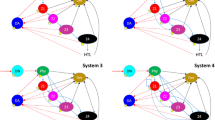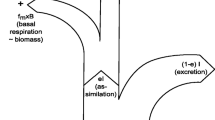Abstract
The purpose of this chapter is to describe a systems model which uses data on arthropods, nematodes, plants, other organisms, and weather to simulate energy flow involving invertebrates in the ecosystem. This model was used for the invertebrate computations included in Chapter 5.
Access this chapter
Tax calculation will be finalised at checkout
Purchases are for personal use only
Preview
Unable to display preview. Download preview PDF.
Similar content being viewed by others
References
Chapman, R. F. 1969. The Insects: Structure and Function. London: English University Press.
Danilevski, A. S. 1965. Photoperiodism and Seasonal Development of Insects. Edinburgh: Oliver and Boyd.
Ellis, J. E., J. A. Wiens, C. F. Rodell, and J. C. Anway. 1976. A conceptual model of diet selection as an ecosystem process. J. Theor. Biol. 60:93–108.
Ferris, H. 1976. Development of a computer simulation model for a plant-nematode system. J. Nematol. 8:255–263.
Grimm, R. 1973. Zum Energieumsatz phytophager Insekten. Untersuchungen an Populationender Rüsselkäfer Rhynchaenus fagi, Strophosomus, und Otiorrhynchus singu-laris. Oecologia 11:187–262.
Hemmingsen, A. M. 1960. Energy metabolism as related to body size and respiratory surface, and its evolution, p. 7–110. In Steno Memorial Hospital and Nordisk Insulin Laboratorium Report, Vol. 9, Part 2.
Keister, M. and J. Buck. 1974. Respiration: Some exogenous and endogenous effects on rate of respiration. In M. Rockstein (ed.), The physiology of Insecta 2nd ed. Vol. 6, pp. 469–509.
Marchant, R. and W. L. Nicholas. 1974. An energy budget for the free-living nematode Pelodera (Rhabditidae). Oecologia 16:237–252.
McNeill, S. 1971. The energetics of a population of Leptoptera dolabrata (Heteroptera: Miridae). J. Anim. Ecol. 40:127–140.
Mercer, E. K., and E. J. Cairns. 1973. Food consumption of the free-living aquatic nematode Pelodera chitwoodi. J. Nematol. 5:201–208.
Mitchell, J. E., 1975. Variation in food preferences of three grasshopper species (Acridi-dae: Orthoptera) as a function of food availability. Am. Midl. Nat. 94:267–283.
Mitchell, J. E. and R. F. Pfadt. 1974. A role of grasshoppers in a shortgrass prairie ecosystem. Environ. Entomol. 3:358–360.
Mittler, T. E. 1958. Studies on the feeding and nutrition of Tuberolachnus salignus (Gmelin) (Homoptera, Aphididae). II. The nitrogen and sugar composition of ingested phloem sap and excreted honeydew. J. Exp. Biol. 35:74–84.
Moulder, B. C. and D. E. Reichle. 1972. Significance of spider predation in the energy dynamics of forest floor arthropod communities. Ecol. Monogr. 42:473–498.
Nicholas, W. L. and S. Viswanathan. 1975. A study of the nutrition of Caenorhabditis briggsae (Rhabditidae) fed on 14C and 32P-labeled bacteria. Nematologica 21:385–400.
Nielsen, C. O. 1961. Respiratory metabolism of some populations of enchytraeidae worms and free-living nematodes. Oikos 12:17–35.
Parton, W. J. 1978. Abiotic section of ELM. In G. S. Innis (ed.), Grassland Simulation Model. Ecological Studies, 26, pp. 31–53. New York: Springer-Ver lag.
Robbins, R. T. and K. R. Barker. 1974. The effects of soil type, particle size, temperature, and moisture on reproduction of Belonolaimus longicaudatus. J. Nematol. 6:1–6.
Rockstein, M. (ed.) 1964. The Physiology of Insecta (3 vols.). New York: Academic Press, Inc.
Schroeder, L. A. 1973. Energy budget of the larvae of the moth Pachysphinx modesta. Oikos 24:278–281.
Smalley, A. E. 1960. Energy flow of a salt marsh grasshopper population. Ecology 41:672–677.
Sohlenius, B. 1968. Influence of microorganisms and temperature upon some Rhabditid nematodes. Pedobiologia 8:137–145.
Van Hook, R. I., Jr. 1971. Energy and nutrient dynamics of spider and orthopteran populations in a grassland ecosystem. Ecol. Monogr. 41:1–26.
Van Hook, R. I. and G. J. Dodson. 1974. Food energy budget for the yellow poplar weevil, Odontopus calceatus (Say). Ecology 55:205–207.
Waldbauer, G. P. 1968. The consumption and utilization of food by insects. Adv. Insect Physiol. 5:229–288.
Wasilewska, L., and E. Paplinska. 1975. Energy flow through the nematode community in a rye crop in the region of Poznan. Polish Ecological Studies 1(3):75–82.
Wiegert, R. G. 1964. Population energetics of meadow spittlebugs (Philaenus spumarius L.) as affected by migration and habitat. Ecol. Monogr. 34:217–241.
Wiegert, R. G. 1965. Energy dynamics of the grasshopper populations in old field and alfalfa field ecosystems. Oikos 16:161–176.
Editor information
Editors and Affiliations
Rights and permissions
Copyright information
© 1979 Spriger-Verlag New York Inc.
About this chapter
Cite this chapter
Scott, J.A. (1979). An Ecosystem-Level Trophic-Group Arthropod and Nematode Bioenergetics Model. In: French, N.R. (eds) Perspectives in Grassland Ecology. Ecological Studies, vol 32. Springer, New York, NY. https://doi.org/10.1007/978-1-4612-6182-7_7
Download citation
DOI: https://doi.org/10.1007/978-1-4612-6182-7_7
Publisher Name: Springer, New York, NY
Print ISBN: 978-1-4612-6184-1
Online ISBN: 978-1-4612-6182-7
eBook Packages: Springer Book Archive




